|
西方文明史Western Civilization (1) & (2)
|
英文系
蘇文伶與墨樵、
Wen-ling Su & Joseph Murphy
|
製作日期
July 2011
|
|
 網頁教材
網頁教材 |
|
| 歷史斷代 Historical Periods
|
1.希臘時期 The Greeks
2.中世紀時期 The Middle Ages
3.文藝復興 Renaissance
4.北方文藝復興 Northern Renaissance
5.巴洛克時期The Age of Baroque
6.啟蒙時期Enlightenment
7.浪漫時期The Romantics
8.現代主義 Modernism
9.現代主義研究 Modernism Survey
10.後現代主義 From Modernism to
Postmodernism |
|
Modernism Survey |
|
I. Elements
of Modernism
(Continued)
A.
Abstraction
1. Painting:
Cézanne,
Nonobjective art
2. Literature
B.
Primitivism
C.
Experimentation with
time and space
1. Art:
Cubism, Futurism
2. Literature
D.
The
unconscious
1.
Theorists: Freud, Jung
2.
Art: Surrealism
II.
Modern Architecture
A.
Precursor: Sullivan
B.
Modernist architects: Wright, Gropius, Le Corbusier, Mies van der
Rohe,
Pruitt-Igoe
III. Total
War, Totalitarianism, and the Arts
A. Total
Wars: WWI, WWII
B. War
Ideology:
1. Romantic
language of war
2. Modern
irony
C. Rise
of German Fascism
1. Hitler
and Nazi
2. The
Holocaust |
|
I.
Elements of Modernism |
|
A.
Abstraction
B.
Primitivism
C.
Experimentation with
time and space
D.
The Unconscious |
|
A. Abstraction |
|
A.
Abstraction:
1.
nonrepresentational art
2.
self-consciousness of medium
3.
art for art’s sake
Maurice Denis: painting is “a float surface with shapes, lines and
colors assembled in particular order” (Fiero 343) |
|
Abstraction in Painting |
|
The Basket of Apples

Cézanne, “The Basket of Apples.” C. 1895.
Britannica. Web. 27
July 2011.
http://www.britannica.com/EBchecked/media/19596/
The-Basket-of-Apples-oil-on-canvas-by-Paul-Cézanne
Still Life with Peppermint Bottle

Cézanne, “Still Life with
Peppermint Bottle.” c.1894.
Chisnell. Web. 27 July 2011.
http://chisnell.com/art/PostImpressionism/Forms/Gallery.aspx

Cézanne, “Mount Sainte-Victoire
Seen from Bellevue. c. 1882-85.
Baymaugallery. Web. 27 July
2011.
https://sites.google.com/site/baymaugallery/gallery9
Mont Sainte-Victoire
Seen from the Bibemus Quarry

Cézanne, “Mont Sainte-Victoire
Seen from the Bibemus Quarry.” c. 1897.
Baymaugallery. Web.
27 July 2011.
https://sites.google.com/site/baymaugallery/gallery9
Mount Sainte-Victoire

Cézanne, “Mount Sainte-Victoire.” 1904-1906.
Baymaugallery. Web.
27 July 2011.
https://sites.google.com/site/baymaugallery/gallery9 |
|
Abstraction in Literature |
|
A.
Ezra Pound:
1.
imagism:
“rhythmic arrangement of words” producing an emotional “shape”—Pound
inspired by Chinese calligraphy
2.
Pound declared, “make
it new”
3.
Pound, “In a Station
of the Metro” (1926)
B.
Frost, “The Road Not Taken” (1916)
(Fiero 355-58)
Pound’s Explanation of “In a Station of the Metro”
“Three years ago in Paris I got out of a ‘metro’
train at La Concorde, and saw suddenly a beautiful face,
and then another and another, and then a beautiful child’s
face, and then another beautiful woman, and I tried all
that day to find words for what this had meant to me,
and I could not find any words that seemed to me worthy, or as
lovely as that sudden emotion. . . .
And
that evening, as I went home along the Rue Raynouard, I was still
trying and I found, suddenly, the expression. I do not mean
that I found words, but there came an equation . . . not in
speech, but in little splotches of colour.”
(Emphasis added.
http://www.english.illinois.edu/maps/poets/m_r/pound/metro.htm) |
|
B. Primitivism |
|
A.
Modernist influenced by
traditional cultures of Africa and Oceania (Gauguin, Picasso, etc.)
B.
Background: 1889 Paris
Exposition Universelle showed arts of Asia, Africa and Oceania.
C.
Rise of anthropology:
Sir James Frazer, The Golden Bough, a comparative study of
traditional folk customs.
D.
Modernist interest in
primitive cultures arose from contact with those cultures.
E.
Ironically, this contact
contributed to the destruction of those cultures.
F.
Modernist primitivism is
therefore nostalgic.
(Fiero 340-42)
|
|
C.
Time and Space: Experimentation |
|
A.
Background:
1.
Einstein’s special
theory of relativity: time and space related
(Fiero 354)
2.
Henri Bergson:
duration: the fusing or streaming together of past and present:
“perpetual becoming” (Fiero 321-22)
B.
Painting (spatial
medium): introduces time
C.
Literature (temporal
medium): introduces space: “Spatial Form” |
|
Cubism |
|
A.
Analytic:
through multiple perspectives, time enters into the space of the
canvas
B.
Synthetic:
real objects pasted onto the canvas—presentation and representation
merge together
(Fiero 359-62)

Picasso, “Man with a Violin.”1912.
Angel-art-house. Web. 27 July 2011.
http://www.angel-art-house.com/oil_paintings_artists/p/PicassoPablo/Man_with_a_Violin_1912.htm

Picasso, “Daniel-Henry Kahnweiler.”
1910. Wikipedia. Web. 27 July 2011.
http://en.wikipedia.org/wiki/File:Picasso_Portrait_of_Daniel-Henry_Kahnweiler_1910.jpg

Braque, “Still Life on a Table.”
c. 1914. Artchive. Web. 27 July 2011.
http://www.artchive.com/artchive/B/braque/gillette.jpg.html
|
|
Literature and Time—Space Experimentation |
|
A.
Literature (temporal
medium) calls attention to space of the text: “Spatial Form” (see
e.e. cummings [in Fiero 389])
B.
Disruptions in
experience of time (stream of consciousness):
1.
Proust, Remembrance
of Things Past (in Fiero 384-85);
2.
Joyce, Ulysses;
Jarrell, “The Death of the Ball Turret Gunner” (in Fiero 418) |
|
Futurism |
|
A.
Marinetti issued
Futurist manifestoes
B.
Focus on modern
sensation: “A roaring motorcar is more beautiful than the winged
Victory of Samothrace.”
(Fiero 362-65)
|
|
Nonobjective Art—Abstract Art |
|

Mondrian, “Brabant Farmyard.”
1904. Oberlin. Web. 27 July 2011.
http://www.oberlin.edu/amam/Mondrian.htm |
|
Piet Mondrian
(1872-1944) |
|
-Dutch Painter
|
|
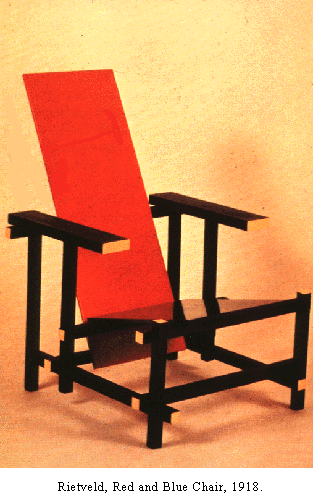
Rietveld, “Red and Blue
Chair.” 1918. Web. Blogspot. 27 July 2011.
http://varshika-rai.blogspot.com/2009/05/architecture-you-can-sit-on.html
 |
|
II.
Modern Architecture |
|
A. Precursor
|
|
Louis Henry Sullivan
(1856-1924) |
|
A.
mastered high-rise
construction using the load-bearing steel frame
B.
1871 Chicago Fire
provided a clean slate for Chicago buildings
C.
1885 Home Insurance
Building (Jenney), Chicago: steel frame but traditional façade
D.
1891 Monadnock Building
(Burnham & Root): limit of bearing-wall construction: 16 floors
E.
1894-5 Guaranty Building
(Sullivan and Adler), Buffalo, NY: vertical piers dominate the
pattern and emphasize verticality
(Fiero 315-16) |

Sullivan and Adler, “Guaranty
Building.” Buffalo, 1894-95. 25 October 2011
http://www.arthistory.upenn.edu/spr01/282/w2c2i26.htm
|
|
|
B. Modernist Architects |
|
Frank Lloyd Wright
(1867-1959) |
|
A.
Student of Sullivan
B.
Stressed
horizontality
C.
Influenced by Japanese
architecture
D.
Founded the so-called
Prairie School
(Fiero 372-73)
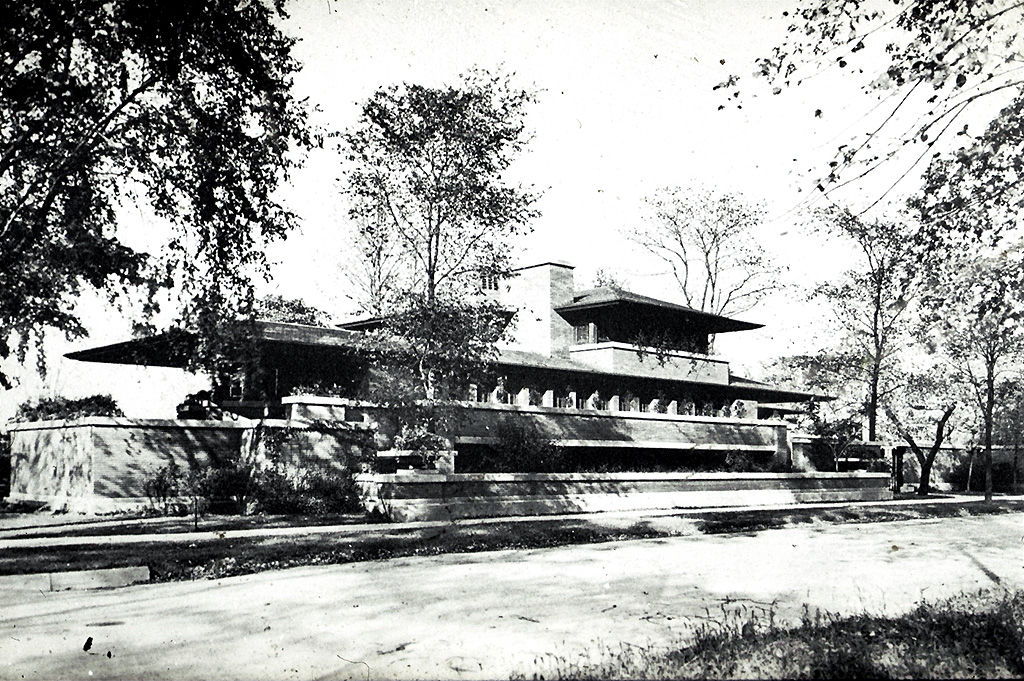
Wright, “Robie House.”Chicago
,1909. 25 October 2011
http://www.curatedmag.com/news/2010/05/17/frederick-c-robie-house-by-frank-lloyd-wright/
|
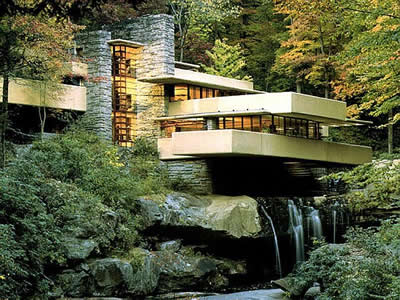
Wright, “Fallingwater.” Pennsylvania, 1936-39.
25 October 2011
http://www.historiasztuki.com.pl/72_ARCHWSP_1-eng.html
|
|
Walter Gropius
(1883-1969) |
|
A.
Founder of the Bauhaus
(“House for Building”) in 1919 through a fusion of Grand Ducal
Academy of Art with the Arts and Crafts School
B.
The idea was to create
an idealistic community of craftsmen, like the medieval cathedral
builders
C.
Wanted to unify
architecture, sculpture, painting, and design
D.
Gropius embraced mass
housing and industrial design
E.
His preferred materials:
steel, concrete, and glass
(Fiero 374)
|
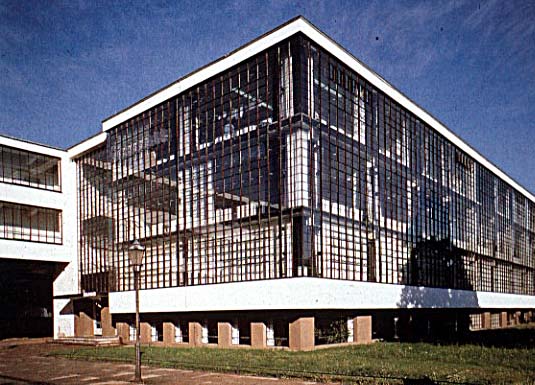
Gropius, “Bauhaus.” Dessau
1925-26. 25 October 2011
http://www.hubert-brune.de/architektur_modern.html |
|
International Style |
|
A.
Emphasis on
truth-telling: no decoration
B.
Subscribed to idea that
form follows function
C.
Building seen as
volume generated by interplay of planes and spaces
D.
Planar flatness of
walls: preference for stucco, which unfortunately cracks
E.
Le Corbusier (France),
Walter Gropius (Germany), Philip Johnson (U.S.)
(Fiero 374) |
|
Le Corbusier and International Style |
|
A.
Le Corbusier was a
failed sociological architect but an inspired aesthetic one
B.
He was among the
founders of the International Style (term coined in 1932 by Philip
Johnson and Henry Russell Hitchcock), as evidenced in his Villa
Savoye, 1929-31
(Fiero 374-76) |
|
Le Corbusier |
|
A.
Promoted La Ville
Radieuse, the “Radiant City”
B.
Voisin Plan of 1925
would clear 600 acre L-shaped site on Right Bank
C.
Get rid of history to
make way for a “vertical city . . . bathed in light and air”
D.
Wanted wide roads for
cars (Voisin was the carmaker that sponsored the research: Peugeot
and Citroen declined)
(Fiero 374-75)

Le Corbusier, “Villa Savoye,”
Poissy, France, 1929-31. 25 October 2011
http://www.public.iastate.edu/~crickord/Villa%20Savoye%20button.html
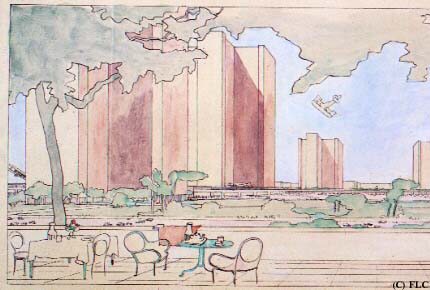
Le Corbusier, Ville
contemporaine pour trois million d’habitants, 1922.25 October 2011
http://madrid2008-09.blogspot.com/2009/03/apuntes-martes-10-de-marzo.html |
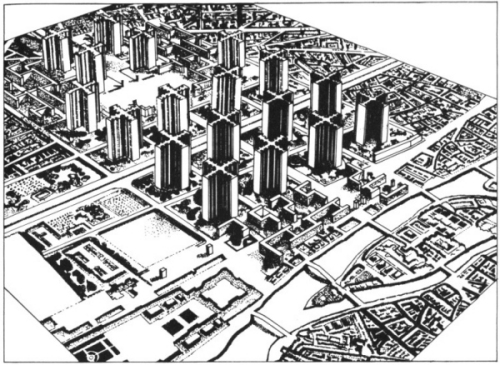
Le Corbusier, “Drawing for the
Voisin Plan,”1925. 25 October 2011
http://www.historiasztuki.com.pl/72_ARCHWSP_1-eng.html
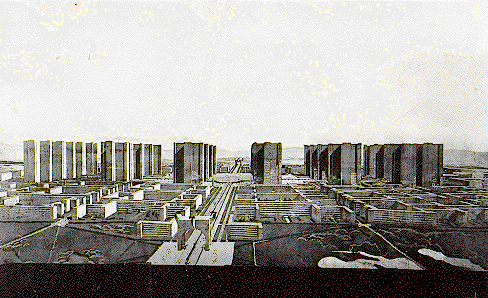
Le Corbusier, “Drawing for the Voisin Plan,”1925. 25 October 2011
http://www.ad.ntust.edu.tw/grad/think/
HOMEWORK/University/corbusier/a9013038/index.htm |
|
Le
Corbusier, Unite d’Habitation,
Marseilles (1946-52) |
|
A.
A one-unit Radiant City
B.
Influenced by utopian
ideas of Charles Fourier (1772-1837)
C.
18 stories, containing
flats for 1600 people
D.
Unrealistic: shopping
mall on the 5th floor, but the French shop in outdoor
markets
E.
Roof is sun-drenched,
simple, the only successful part of the building
What
Can we Learn From Corbusier’s failures?
-Modernist principles might be
good for a painting, or even a house, but they do not succeed as a
basis for organizing a city or society.
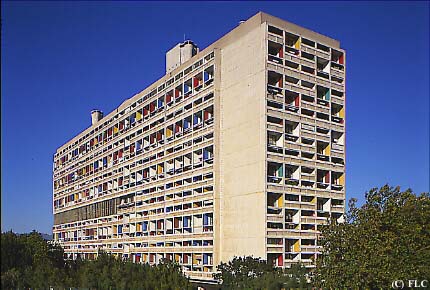
Le Corbusier, “Unite
d’Habitation.” Marseilles, 1946-52. 25 October 2011
http://litspat.medialoperations.com/files/2010/05/unite-dhabitation-marseille.jpg |
|
Ludwig Mies van der Rohe
(1886-1969) |
|
A.
mastered the use of
glass in the steel-frame skyscraper, creating the face of the modern
corporation
B.
linear, rational, and
(in theory) cheap
C.
believed in an objective
architecture based on the machine age; rejected ornaments, calling
them “noodles”
D.
Philip Johnson said:
“[Mies] believed in the ultimate truth of architecture, and
especially of his architecture.”
E.
1954-58 Seagram
Building: made the curtain wall of bronze because he wanted a warm
dark color: most elegant but most expensive curtain wall ever hung
on steel frame
(Fiero
443-44) |
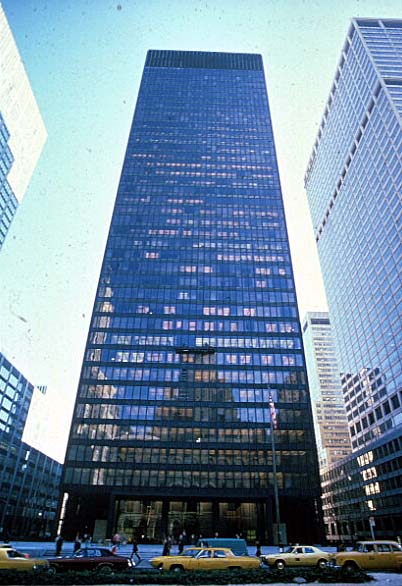
Ludwig Mies van der Rohe,
Seagram Building, New York, 1954-58. 25 October 2011
http://www.ou.edu/class/arch4443/
50's%20Minimalism/Seagram%20Building.jpg
|
|
Pruitt-Igoe and the End of Modernity |
|
“The first building was demolished on March 16, 1972 shortly after
3:00 PM. The demolition of the entire complex was completed in 1976.
Today, much of the site still stands vacant, except for the school,
Gateway Institute of Technology, located on Jefferson Avenue near
Cass Avenue, at the western end of the Pruitt-Igoe tract.”
“The failure of Pruitt-Igoe represents to many the failure of
modernist thinking and high-tech solutions to social problems
(rational planning built on objectivist models of human behavior).”
http://www.umsl.edu/~keelr/010/pruitt-igoe.htm
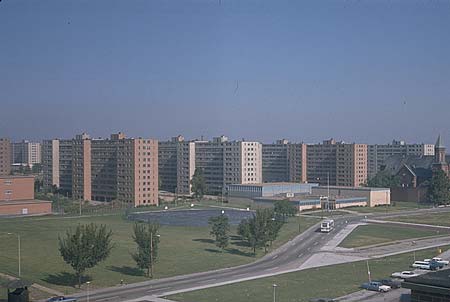
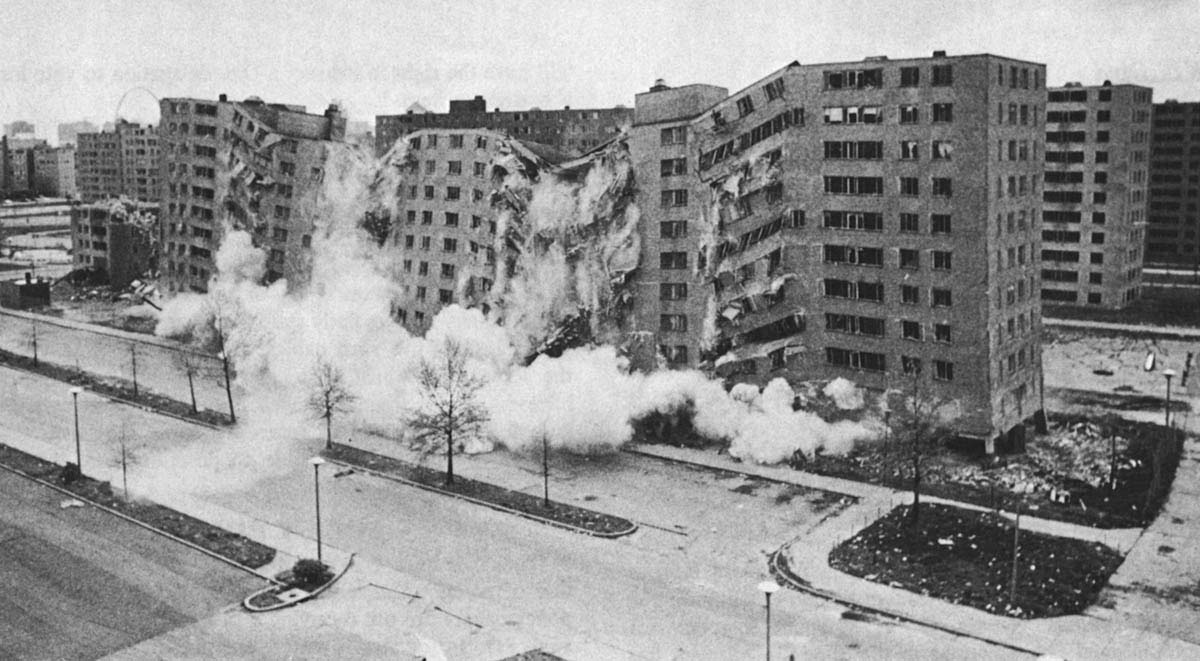
George Hellmuth and Minoru
Yamasaki, Pruitt-Igoe Project, St. Louis, MO, 1956.
http://www.umsl.edu/~keelr/010/pruitt-igoe.htm |
|
The
Freudian Revolution |
|
The Revolt
of the Unconscious Against Civilizing Forces |
|
Sigmund Freud
(1856-1939) |
|
A.
Like Marx, a
determinist
B.
People determined by
their instincts
1.
Life instinct: sex
(libido)
2.
Death instinct:
aggression, self-destruction |
|
Freud: The
Psyche |
|
A.
Id:
the raw instincts
B.
Ego:
the manager of the id that sublimates the instincts
C.
Superego:
the “conscience” that manages the ego according to social standards
and morality
(Fiero 381) |
|
Sublimation
vs. Repression |
|
A.
Sublimation=positive
redirection/ modification of instincts
B.
Repression:
When an instinct is not sublimated but frustrated. The instinct does
not go away but takes the form of a neurotic symptom
(Fiero 281-82) |
|
Civilization and its Discontent
(1930) |
|
A.
Causes of suffering
1.
Body
2.
External world
3.
Relations with others
B.
Freud: methods to avoid
suffering
1.
Voluntary isolation
(avoid suffering from others)
2.
Human community (avoid
suffering from external world)
3.
Intoxication
4.
Sublimation: art,
science
5.
Delusion: alternative
reality
6.
Mass delusion = religion
(Fiero
382-84) |
|
Freud & the
Arts |
|
A.
Liberate the unconscious
mind—an escape from “civilization”
B.
Stream of consciousness
(literature): Proust, Joyce, Faulkner, Woolf
C.
Surrealism:
1.
literature: Kafka
2.
visual arts: Miro, Klee,
Dali, Kahlo, Magritte |
|
André
Breton (1896-1966) |
|
“Surrealist Manifesto”
(1924)
SURREALISM, n. “Psychic
automatism in its pure state, by which one proposes to express --
verbally, by means of the written word, or in any other manner --
the actual functioning of thought. Dictated by the thought, in the
absence of any control exercised by reason, exempt from any
aesthetic or moral concern” (http://www.artic.edu/reynolds/essays/hofmann3.php).
|
|
Film:
Un Chien Andalou (1929)
(“An Andalusian Dog”) |
|
A.
By Luis Buñuel and
Salvador Dali Principle: surrealism/dream sequence; Buñuel: “no idea
or image that might lend itself to a rational explanation of any
kind would be accepted.” Only psychoanalysis might explain it.
B.
Famous images:
1.
woman’s eye being slit
as cloud passed over moon;
2.
ants crawling out of
hole in man’s palm;
3.
man carrying Ten
Commandments, pulling pianos with rotting donkeys and two priests
(one played by Dali himself). |
|
Carl Jung
(1875-1961) |
|
Collective unconscious
A.
Not personal, but shared
by human beings in general
B.
Encoded as archetypes:
basic images, plot patterns, or character types reflecting the deep
psychological needs of human beings, found in folklore, religious
texts, & literature
C.
E.g., the child god, the
hero, the wise old man
|
|
(left) Munch, “The Scream.” 1893.
Wikipedia. Web. 28 July 2011.
http://en.wikipedia.org/wiki/The_Scream
(middle) Dali, “The Persistence of
Memory.” 1931. Wikipedia. Web. 28 July 2011.
http://en.wikipedia.org/wiki/The_Persistence_of_Memory
(right) Picasso, “Seated Woman.”
1927. Abacus-gallery. Web. 28 July 2011.
http://www.abacus-gallery.com/cgi-bin/shop/shop.pl?fid=1285836587&cgifunction=form
 |
|
III. Total War,
Totalitarianism, and the Arts
ca. 1900-1950 |
|
A. Total
Wars: WWI, WWII |
|
World War
I: Causes
A.
Extreme nationalism
(roots in the 19th century)
B.
Militaristic view of war
as heroic; highest expression of nation and individual
C.
Hostile alliance system
(Fiero 405)
|
World War One 1914-18
|
Allied Powers
-Great Britain
-France
-Russia
-Belgium
-Serbia
-United States
-Italy
-Japan
|
Central Powers
-Germany
-Austria-Hungary
-Ottoman Empire
|
|
World War
Two 1939-45
|
Allied Powers
-France
-Great Britain
-United States
-Soviet Union
|
Axis Powers
-Germany
-Italy
-Bulgaria
-Hungary
-Japan
|
|
|
|
B. War
Ideology |
|
Romantic Language of War |
|
Source:
Paul Fussell, The Great War and Modern Memory (1975)
-Horse =
steed, charger
-Enemy=
the foe
-Danger=
peril
-Conquer=
vanquish
-Brave=
gallant
-The dead=
the fallen
-To die=
perish
|
-Warfare=
strife
-Actions=
deeds
-To win=
conquer
-Quick=
swift
-Sleep=
slumber
-Enlist=
join the colors
-Draft-notice=
summons |
|
Modern
Warfare: WWI |
|
A.
Trenches, barbed wire,
machine guns
B.
Long battles without
consequence (600,000 killed at Verdun, but nothing achieved)
C.
Propaganda necessary to
keep soldiers and civilians supporting the war
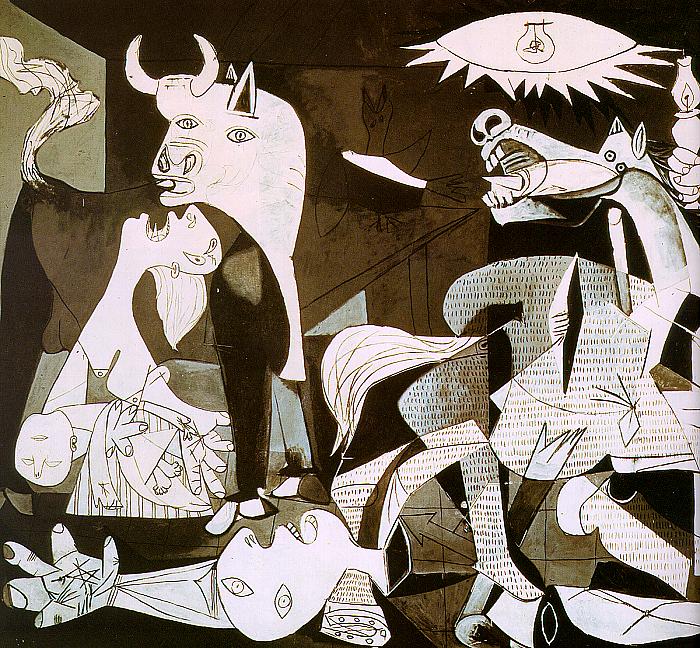
Picasso, “Guernica.” 1937.
Wikipedia. Web. 28 July 2011.
http://en.wikipedia.org/wiki/Guernica_(painting) |
|
Modern
Irony |
|
NOTHING is to be written on this side except the
date and signature of the sender. Sentences not required may be
erased.
I am quite well.
I have been admitted into hospital
{sick, wounded} and am going on well.
and hope to be
discharged soon.
I have received your letter dated________
I have received no letter from you {lately/ for a
long time}
Signature only
Date____________________________________
Source: Paul Fussell, The Great War and Modern Memory (1975) |
|
War and
Irony in Literature |
|
A.
Owen, “Dolce et Decorum
Est” (1918)
B.
Yeats, “The Second
Coming” (1921)
C.
Jarrell, “The Death of
the Ball Turret Gunner” (1945)
D.
Joseph Heller,
Catch-22 (1955)
E.
Stanley Kubrick, Dr.
Strangelove (Film, 1964) |
|
C. Rise
of German Fascism |
|
Causes
A.
Humiliation from defeat
in WW I
B.
Treaty of Versailles:
$33 billion war debt; German army limited to 100,000
C.
Inflation: Gov. printed
more money to pay debt; money became almost worthless—then Great
Depression in 1929
(Fiero 416-18) |
|
Adolf
Hitler
(1889-1945) |
|
A.
Born 1889, Austria:
undisciplined, poor student
B.
Went to Vienna to study
art, rejected from art academy
C.
Became anti-Semitic and
anti-Marxist |
|
Rise of
Hitler and
National Socialist Workers’ Party (Nazi) |
|
A.
1928: 12 seats in
Reichstag (800,000 voters)
B.
1930: 107 seats in
Reichstag (6.5 mill voters)
C.
1933: Hitler becomes
chancellor, then Reichstag gives him dictatorial power
Note: Hitler was a product of democracy |
|
Nazi
Ideology |
|
A.
Celebrated German soil
and German blood
B.
Romantic view of German
peasants
C.
The enemy: the city,
industry, modernity
D.
The scapegoat: the Jews |
|
Nazi
View of Jews |
|
A.
Outsiders: from outside
Europe (corrupting the German blood)
B.
Urbanites (corrupting
the German land)
C.
Businessmen/financiers
(corrupting the German economy)
D.
Intellectuals and
artists (corrupting German culture) [Marx and Freud were both
Jewish] |
|
Nazi
View of Art |
|
A.
Classicism and
Romanticism are best
B.
Subjects: Good-looking
German peasants; rural scenes
C.
Form: Representational
art (experimental, distorted, and non-representational arts are
“degenerate”)
D.
Exhibit mocking Modern
Art in 1937 called “Degenerate Art”: Entartete Kunst
|
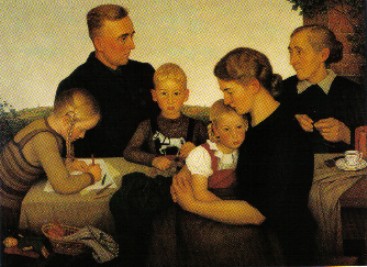
Wissel, “Farm Family from Kahlenberg.”
1939.
Skidmore. Web. 28 July 2011.
http://www.skidmore.edu/
academics/fll/german/enemy/Naziart/workart.html
|

Emil Nolde, “Christus und die Sünderin [Christ and the Sinner].”
1926. Gmu. Web. 27 July 2011.
http://mason.gmu.edu/~mhobbs/
entartetekunst/room1/nolde_sunderin.htm |
|

“Hitler with Myron’s Discobolus.”1938.
Blogspot. Web. 28 July 2011.
http://consumingantiquity.blogspot.com/2010/09/hitler-and-discobolus.html
|

Max Beckmann, “Christus und die Ehebrecherin
[Christ and the Adulteress].” 1917. Gmu. Web. 27 July 2011.
http://mason.gmu.edu/~mhobbs/entartetekunst/
room1/beckmann_christus.htm
|
|
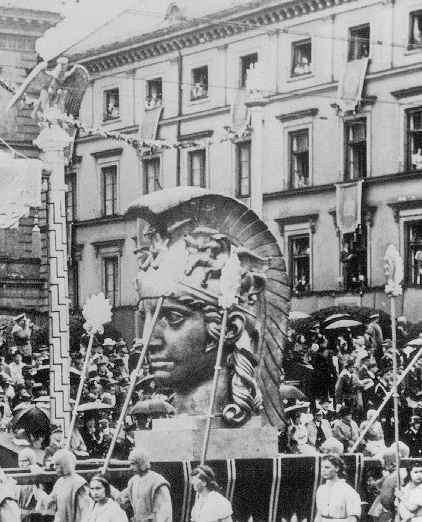
Pageant for the Day of German Art 1939, Munich.
25 October 2011
http://thecensureofdemocracy.150m.com/art5.htm
|
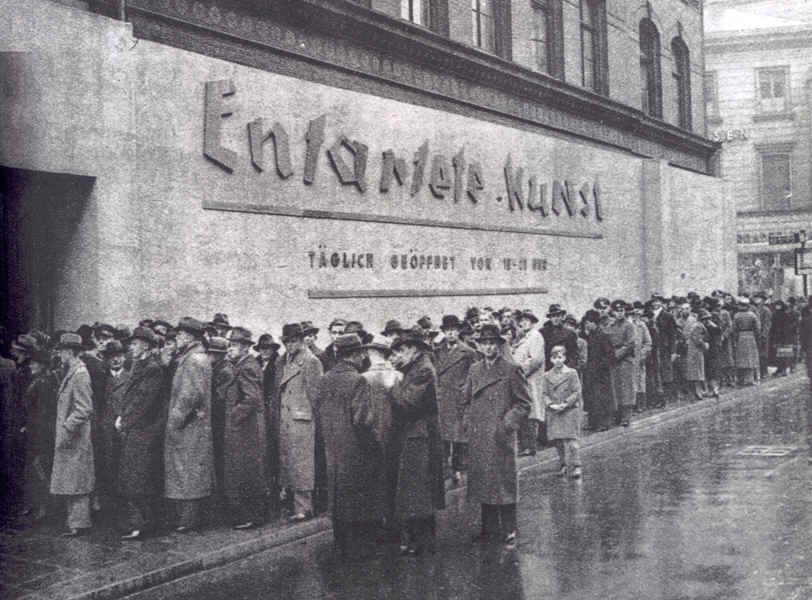
Entartete Kunst, “Degenerate Art Exhibit.” 1937.
Thefileroom. Web. 27 July 2011.
http://www.thefileroom.org/documents/dyn/DisplayCase.cfm/id/1146
|
|
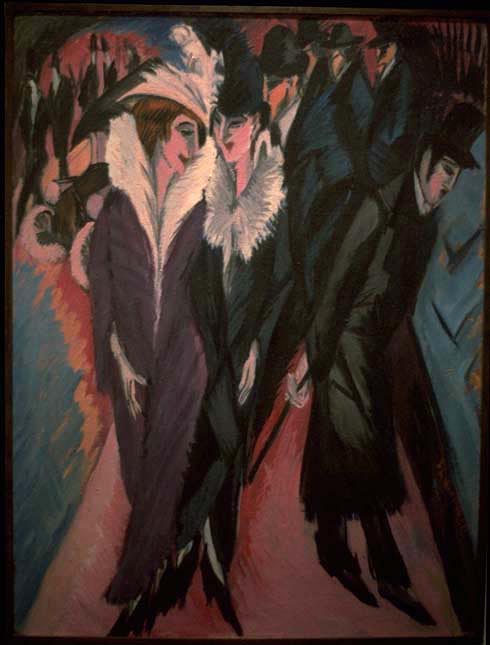
Kirchner, “Street, Berlin.” 1913. Moma. Web.
27 July 2011.
http://www.moma.org/collection/object.php?object_id=79354
|
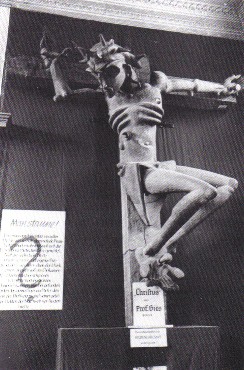
Gies, “Crucified Christ.” (at Degenerate Art
exhibit). 1921.
Tumbler. Web. 27 July 2011.
http://fuckyeaarthistory.tumblr.com/post/978706369/
ludwig-gies-crucified-christ-wood-1921
|
|
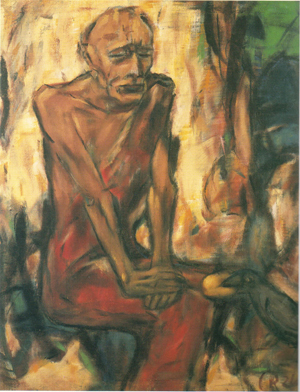
Christian Rohlfs, “Elias, wird vom Raben gespeist
[Elijah fed by ravens].” 1921. Gmu. Web. 72 July 2011.
http://mason.gmu.edu/~mhobbs/entartetekunst/
room1/rohlfs_elias.htm |
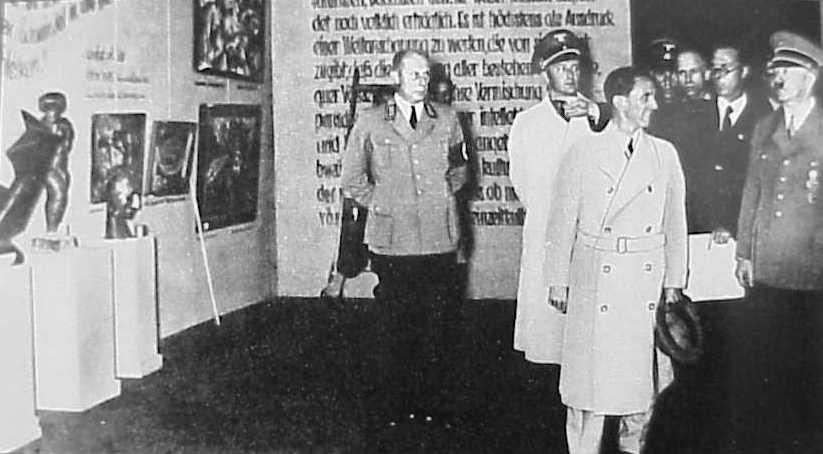
Source: Hitler Visits Degenerate Art Exhibit
(from:
http://www.greatesttheft.com/lessonplan.php?id=1)
Hitler Visits Paris for the First Time, June 22,
1940
YouTube - Hitler In Paris |
|
|
The
Holocaust |
|
A.
The Nazis passed laws to
put Jews in ghettos
B.
Then they passed laws to
move Jews to concentration camps, where 6,000,000 were murdered
C.
5,000,000 non-Jews also
exterminated |
|
The
Holocaust: Uniqueness |
|
A.
Focused: singled out
Jews as target ethnic group (but Roman Catholics, gypsies,
homosexuals, handicapped also killed)
B.
Official: it was the law
C.
Systematic: technology,
bureaucracy, industry all work toward this goal
D.
Effective: 2/3 of Jewish
population of Europe murdered
Elie Wiesel at Auschwitz (with Oprah Winfrey)
YouTube - Oprah and Elie
Weisel at Auscwitz Part 1 |
|
End of WWII |
|
A.
Background: US drops
atomic bomb on Hiroshima, Japan, August 6, 1945, killing
90,000-166,000, mostly civilians
B.
Second bomb on Nagasaki,
Aug. 9, 1945, killing 60,000-80,000
C.
Japanese surrender, Aug.
15, 1945
(Fiero 417-18)
|

Krzysztof Penderecki, “Threnody in Memory of the Victims of
Hiroshima.” 1960.
Wikipedia. Web. 27 July 2011.
http://zh.wikipedia.org/wiki/File:Atomic_cloud_over_Hiroshima.jpg
|
|
|
Krzysztof
Penderecki,
Threnody in Memory of the Victims
of Hiroshima
(1960) |
|
A.
10 min. lamentation,
written for 52 stringed instruments
B.
Begins with screaming
tone at highest pitch of violins
YouTube - Krzysztof Penderecki
- Threnody for the Victims of Hiroshima |
|
Works Cited |
|
Fiero, Gloria K. The Humanistic Tradition.
Vol. 2. 6th ed. New York: McGraw-Hill, 2011.
Fussell, Paul. The Great War and Modern Memory. New York:
Oxford UP, 1975.
 |